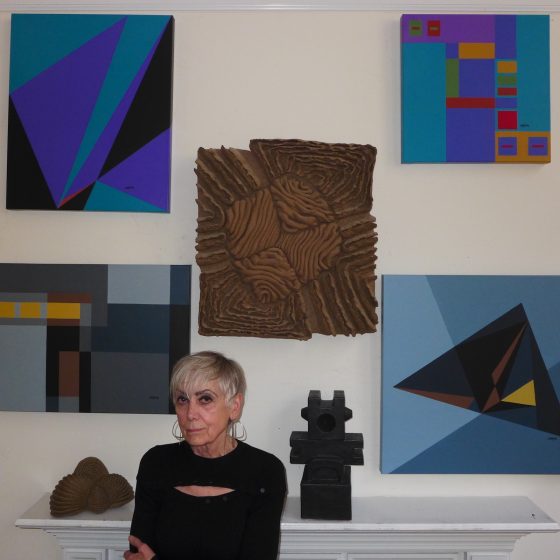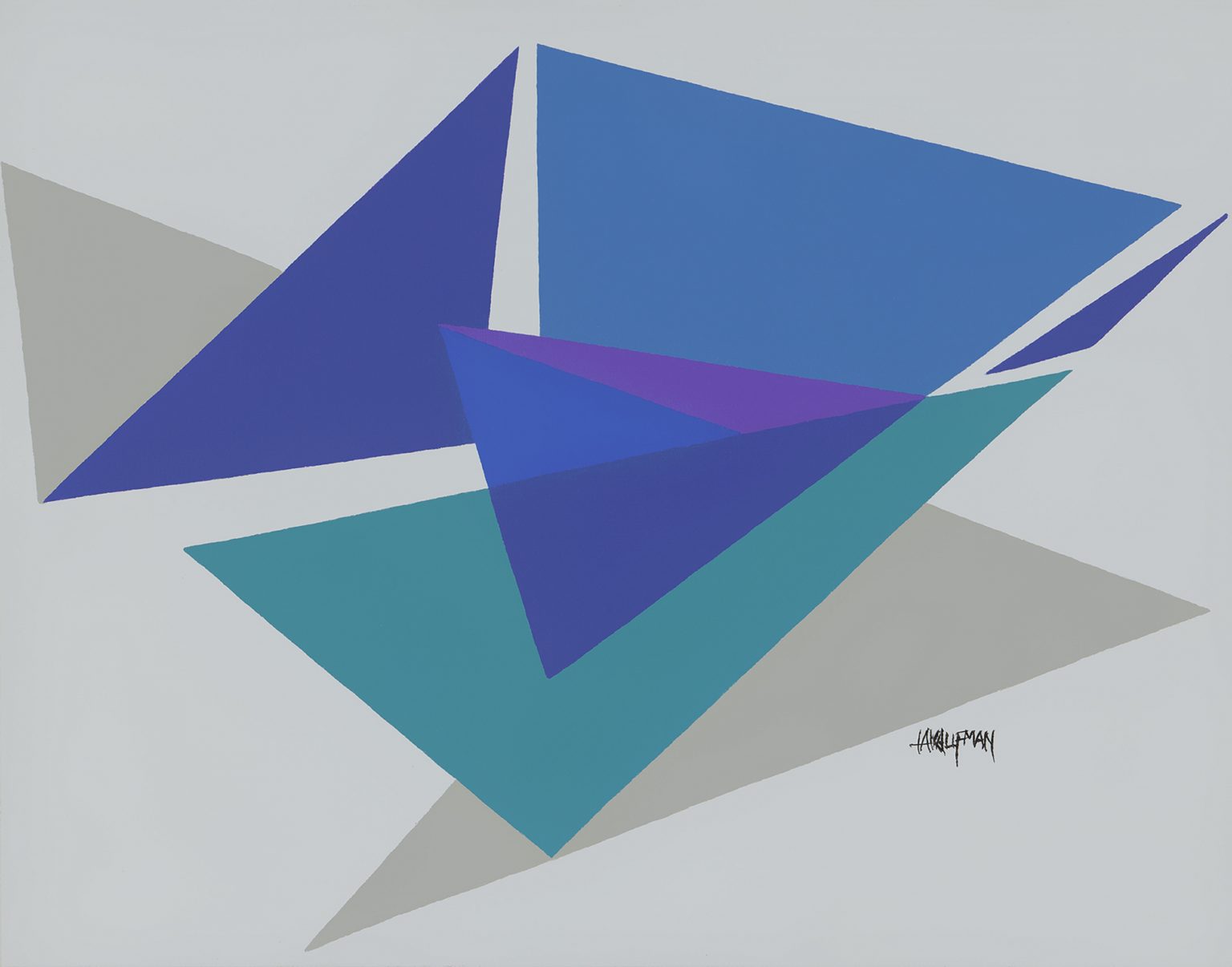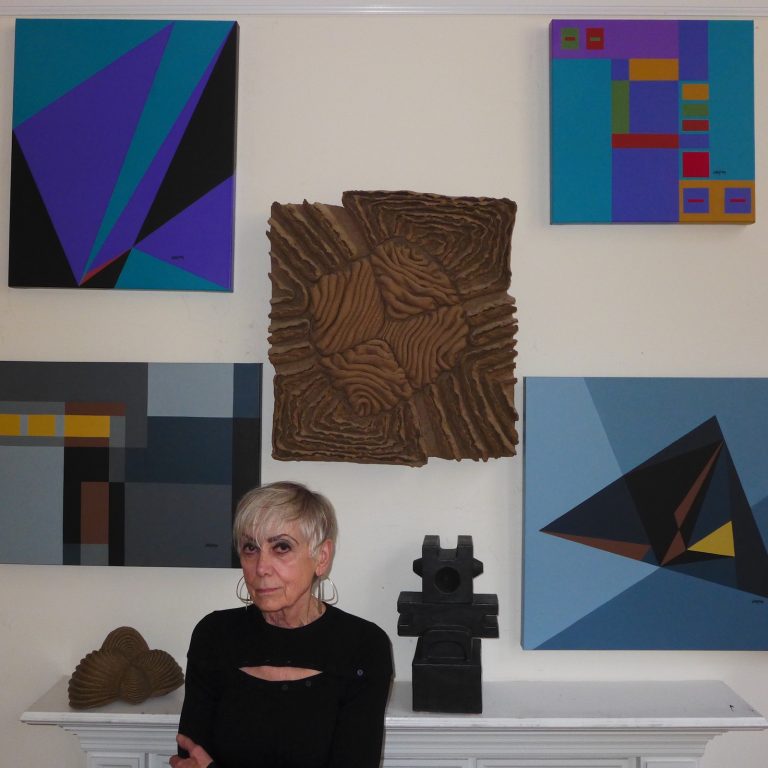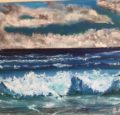Loretta Ana Kaufman has been an Artweb member for many years, and we reached out to her for an interview after hearing her work was to go into the permanent collection of the CICA museum in South Korea.
Can you tell us a little about yourself and your work?
I’m originally from New York, spent most of my childhood in Venezuela and now live in Nashville, Tennessee.
After working with clay for many years a transition was made to paint, paper, metal, wood, and fibre in 2005. I’m currently working on several series with oil and acrylic paint and some of the themes are Quartet, Family Group, Double Monologues. They have also been recurring themes in my sculptural, mixed media and collage work.

What were your motivations for becoming an artist? When did you realise this was something you wanted to pursue and how did you start?
Rural, Venezuela where we lived was an untamed, wild, and predominantly barren place. When it was hot and dry we were frequently in and around the El Tigrito River, so there was an early connection to nature. Later we relocated to the Bahamas which was in stark contrast to the llanos of eastern Venezuela. Exploring Grand Bahama and the reefs that surround it gave me a new perspective about this amazing part of our planet. Following graduation from college and while working at a university in Florida, I began taking art classes whenever possible.
A move to South Africa and working under a ceramic artist for several years was the first step to devoting full time to my art practice. During this time functional ceramics were produced for retailers in Pretoria and Johannesburg. Living on a 600 hectare farmstead for three years outside Pretoria opened up a new world and I discovered a country with abundant wildlife, much raw beauty, a rich diversity of both fauna and flora, as well as outgoing South Africans. The farmstead was bordered by mountains and adjacent to a dam. Secretary birds, black-backed jackals, mongoose, civet cats, giant termite mounds, baobob trees, black mambas, and rinkhals cobras were on the property. There were trips to the Eastern and Western Cape, Zululand, the Great Karoo and beyond. All of this would become significant influences in my work.
What and who inspires your art?
Whether working with paint or other materials the inspiration is the same. I get my ideas by looking around me and being sensitive to my surroundings. It is hard to pin down as there are many things that interest me in the natural world. Issues like awareness, genetically modified food organisms, animal behaviours, polar ice melt, dead zones, and male/female relationships. Sitting around and waiting for an idea is the worst thing to do. Ideas come out of the work, as well as go into it, so it is important to me to have a strong work ethic.
Can you talk us through your process?
This is a big question with moveable parts. In my work nature and the life around us are the sparks that start the process. When painting with acrylics it begins with a small sketch, and often more detailed studies or drawings are necessary. Paints are mixed after a decision about colour is made and then scale of the final piece is worked out. But not always. Sometimes this part of the process is reversed where scale is considered before colour. Priming the canvas with several coats of gesso is the next step prior to starting the work. Paint is applied with brushes as opposed to using a roller and tape to achieve that hard edge.
What’s been the highlight of your career so far?
While living in South Carolina the State Arts Commission had a residency open at an elementary school. The school was located in a rural part of the county and would be with grades 2-5. Since the students had little or no experience working with clay as an art form my thoughts were to go forward with a residency that focused on the environment. To motivate the students I presented a video about the South American rainforest and talked about the diversity of life. Being a member of the Sierra Club one of our members was invited to discuss the environment with the classes. My plan was to build animal sculptures with clay: from the water, the air and then the land. We made fish, birds and African tumble bugs.
The intention was not to create perfect sculptures but to make children more aware and respectful of their environment. To get a message across that all these creatures are unique, and of the earth, and it is the only one we have. At the same time of this residency my stoneware wall reliefs were being exhibited in a solo show at the Museum of York County in South Carolina. So we made arrangements to make the 2 hour 100 mile trip by school bus to see the work. A few weeks later the principal contacted me with an invitation to visit the school. The students’ parents were so proud of their accomplishments that they got together and built shelves to display the work at the school. A highlight and very rewarding.

You recently exhibited at the CICA Museum in South Korea. Can you tell us how that came to be?
By replying to an open call for the exhibition ‘Color 2021’ and submitting images and a brief bio. Prior to submittal research was done about shipping costs, crating, required documentation to get the work from Tennessee to South Korea, and about the institution itself. After curatorial review and notification, additional images and specifics about the work to be included in the exhibition, plus lengthy biographical and other documentation were requested.
The painting that was shipped is Animated Forms VI (Family Group): The Blues which received a Merit Award in Grey Cube Gallery’s exhibition ‘Colors’ in 2020. Entries were received from 15 countries. The ‘Color 2021’ exhibition was open to all 2D and 3D media and featured 33 artists to represent Austria, Estonia, Scotland, Brazil, Israel, France, Russia, England, Korea and the US. Having worked with the Blues series for more than a year, the imagery became increasingly abstract and geometric, and the subjects were reduced to bold simplified forms. Wanting to create lots of excitement, tension and space in the canvas, acrylics were used in a vibrant palette of blues, blue greens and violets. At the close of the exhibition the painting was added to the Museum’s Permanent Collection.
Steps other artists might take to exhibit at a museum would depend on the venue and if it is a solo show. Research on the institution is a good idea to see if your work would be a good fit. With CICA Museum (Czong Institute for Contemporary Art) their mission is to introduce innovative and contemporary art produced by artists from different regions and cultures to a global audience. In the earlier one-person exhibition during the South Carolina Arts Commission residency, research indicated that this was a heritage and natural history museum with a naturalist centre and hands on programs. It was a good fit for my sculpture.
What are you working on next?
I work in series usually working between two at the same time. Next up is to work with acrylics producing diptychs and triptychs. To continue with the theme of Animated Forms in Series M, which is my response to the pandemic; and in the black and white series, that began in 2016, to work with variations of Double Monologues and Family Group.
Where can people see more of your work?
In the book of poetry by Peter Waldor ‘Gate Posts With No Gate – The Leg Paint Project’, an oil painting; in the literary and arts journal Still Point Arts Quarterly Summer 2021 Issue, ‘Art of Isolation’ two acrylic paintings; and also see the websites of the Tennessee Arts Commission and the
Carolina Bronze Sculpture Garden
At the New York Public Library, Mulberry Branch (SoHo), New York, NY, in the National Association of Women Artists exhibition ‘Art That Heals’, January 5 – March 31, 2022. And online: https://www.thenawa.org, acrylic diptych; Bank of America, London, England (stoneware wall relief (triptych); Tennessee Arts Commission, Nashville, Tennessee, acrylic painting, stoneware sculpture; San Angelo Museum of Fine Arts, San Angelo, Texas, stoneware wall relief; Environmental Research Foundation, Washington, DC, stoneware sculpture; WestPoint Home, Inc, New York, NY, stoneware sculpture.
You can stay up to date with and see more of Loretta’s work on her website here.







